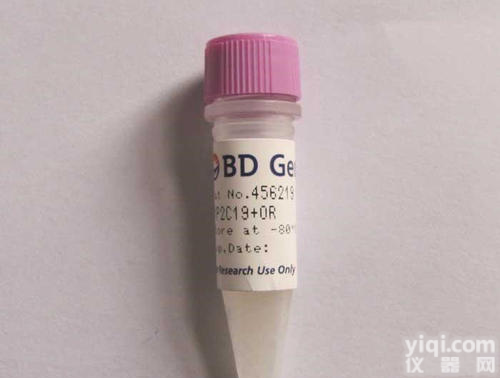产品名称:上皮钙粘附分子抗体,Anti-E cadherin抗体
中文名称:上皮钙粘附分子抗体
英文名称:Anti-E cadherin
产品编号:byk-1519R
产品规格:0.1ml/0.2ml
产品用途:科研实验
性 状: Lyophilized or Liquid
浓 度: 1mg/1ml
亚 型: IgG
贮 存: 贮存于-20℃.
相关标记: HRP Biotin Gold RBITC AP FITC Cy3 Cy5 Cy5.5 Cy7 PE PE-Cy3 PE-CY5 PE-CY5.5 PE-CY7 APC Alexa Fluor 350 Alexa Fluor 488 Alexa Fluor 555 Alexa Fluor 647
我公司拥有领先的细胞服务技术,先进的仪器设备和专业的ELISA检测试剂盒、生物索标记、荧光索标记、酶标记等,广泛用于多种分析研究与技术测定。欢迎来电咨询,我们将竭诚为你服务!
上皮钙粘附分子抗体,Anti-E cadherin抗体 相关产品:
C型凝集素结构域家族4成员A抗体 Anti-DCIR/CLEC4A
炭疽杆菌致死因子LF抗体 Anti-Bacillus anthracis lethal factor
结肠直肠癌缺失基因抗体 Anti-DCC
多巴胺β羟化酶抗体 Anti-DBH
浦肯野细胞萎缩相关蛋白1抗体 Anti-Puratrophin 1/PLEKHG4
多巴胺受体D5抗体 Anti-DRD5/Dopamine receptor 5
多巴胺受体D4抗体 Anti-DRD4
多巴胺转运蛋白DAT抗体 Anti-DAT/Dopamine transporter
神经细胞蜡样质脂褐质沉积病蛋白CLN5抗体 Anti-CLN5
ELAVL2+ELAVL4蛋白抗体 Anti-ELAVL2+ELAVL4
多巴胺受体D3抗体 Anti-DRD3
FAM71D蛋白抗体 Anti-FAM71D
多巴胺受体D2抗体 Anti-DRD2
FAM71A蛋白抗体 Anti-FAM71A
多巴胺受体D1抗体 Anti-DRD1
细胞色素C抗体 Anti-Cytochrome C
神经节苷脂诱导分化相关蛋白1抗体 Anti-GDAP1
细胞色素P450ⅡE1抗体 Anti-CYP2E1
透明质酸合成酶2抗体 Anti-HAS2/Hyaluronan synthase 2
富半胱氨酸肝素结合蛋白61抗体 Anti-Cyr61/IGFBP10/CCN1
抗体规律
(1)初次反应产生抗体:当抗原一次进入机体时,需经一定的潜伏期才能产生抗体,且抗体产生的量也不多,在体内维持的时间也较短。
(2)再次反应产生抗体:当相同抗原第二次进入机体后,开始时,由于原有抗体中的一部分与再次进入的抗原结合,可使原有抗体量略为降低。随后,抗体效价迅速大量增加,可比初次反应产生的多几倍到几十倍,在体内留存的时间亦较长。
(3)回忆反应产生抗体:由抗原刺激机体产生的抗体,经过一定时间后可逐渐消失。此时若再次接触抗原,可使已消失的抗体快速上升。如再次刺激机体的抗原与初次相同,则称为特异性回忆反应;若与初次反应不同,则称为非特异性回忆反应。非特异性回忆反应引起的抗体的上升是暂时性的,短时间内即很快下降。
上皮钙粘附分子抗体,Anti-E cadherin抗体 产品详情:
This gene is a classical cadherin from the cadherin superfamily. The encoded protein is a calcium dependent cell-cell adhesion glycoprotein comprised of five extracellular cadherin repeats, a transmembrane region and a highly conserved cytoplasmic tail. Mutations in this gene are correlated with gastric, breast, colorectal, thyroid and ovarian cancer. Loss of function is thought to contribute to progression in cancer by increasing proliferation, invasion, and/or metastasis. The ectodomain of this protein mediates bacterial adhesion to mammalian cells and the cytoplasmic domain is required for internalization. Identified transcript variants arise from mutation at consensus splice sites.
 上皮钙粘附分子抗体,Anti-E cadherin抗体
上皮钙粘附分子抗体,Anti-E cadherin抗体
![[免疫学试剂] 一抗 抗原<em>抗体</em> Anti-EpCAM/CD326<em>上皮</em>细胞<em>粘附</em>分子/表皮细胞<em>粘附</em>分子<em>抗体</em>](https://item.yiqi.com/pic/CovPic/1/20108910541483.jpg) [免疫学试剂] 一抗 抗原抗体 Anti-EpCAM/CD326上皮细胞粘附分子/表皮细胞粘附分子抗体
[免疫学试剂] 一抗 抗原抗体 Anti-EpCAM/CD326上皮细胞粘附分子/表皮细胞粘附分子抗体
 Phospho-E Cadherin (Ser838 + Ser840)抗体*磷酸化上皮钙粘附分子抗体FITC.PE
Phospho-E Cadherin (Ser838 + Ser840)抗体*磷酸化上皮钙粘附分子抗体FITC.PE
 Anti-Phospho-E Cadherin (Ser838 + Ser840)抗体,磷酸化上皮钙粘附分子抗体
Anti-Phospho-E Cadherin (Ser838 + Ser840)抗体,磷酸化上皮钙粘附分子抗体
 Phospho-E Cadherin (Ser838 + Ser840)抗体 磷酸化上皮钙粘附分子抗体
Phospho-E Cadherin (Ser838 + Ser840)抗体 磷酸化上皮钙粘附分子抗体
 Phospho-E Cadherin (Ser838 + Ser840)抗体 磷酸化上皮钙粘附分子抗体
Phospho-E Cadherin (Ser838 + Ser840)抗体 磷酸化上皮钙粘附分子抗体
 Anti-Phospho-E Cadherin抗体,磷酸化上皮钙粘附分...
Anti-Phospho-E Cadherin抗体,磷酸化上皮钙粘附分...
 0.1ml/0.2ml GRGDS抗体,抗粘附多肽抗体
0.1ml/0.2ml GRGDS抗体,抗粘附多肽抗体
 GRGDS抗体,抗粘附多肽抗体FITC.PE
GRGDS抗体,抗粘附多肽抗体FITC.PE
 Anti-GRGDS抗体,抗粘附多肽抗体
Anti-GRGDS抗体,抗粘附多肽抗体
 Anti-Dysadherin抗体,抗粘附素抗体
Anti-Dysadherin抗体,抗粘附素抗体
 Anti-Dysadherin抗体,抗粘附素抗体
Anti-Dysadherin抗体,抗粘附素抗体